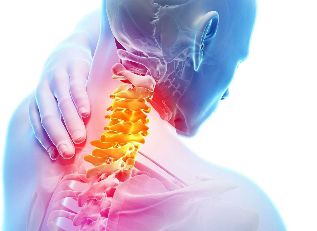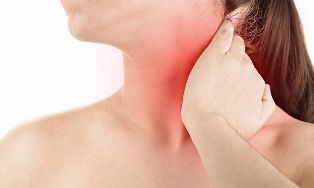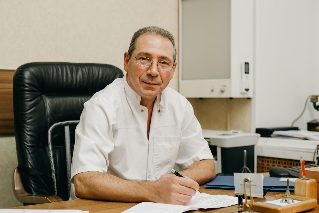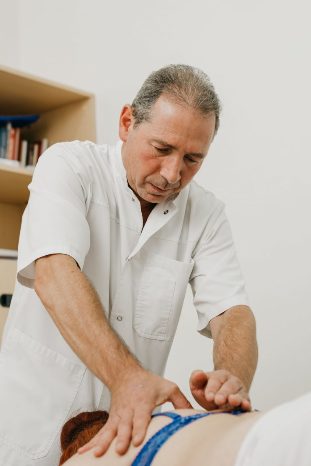Neck pain at different intervals in 70% of adults. At the same time, the painful sensations can not only be of a different nature, but also caused by various diseases. Therefore, they are mainly observed not separately, but accompanied by other symptoms that help to diagnose and select the optimal treatment tactics.
Neck pain type

Neck pain can be short-term and limited to minor discomfort, or very severe, disrupting daily life. More often people complain that they suddenly feel lumbago, after which constant pain occurs. It can be painful, tingling, throbbing, narrowing, or vice versa.
Neck pain is also called cervicalgia.
Discomfort usually increases during movement, for example, when turning or tilting the head, while maintaining a static position, especially uncomfortable for long periods of time, in particular, while working long hours at a computer. In this case, a person is forced, even unconsciously, to turn his whole body in order to tie his neck as much as possible.
So it is clear that neck pain can be very different. Thus, they are divided not only into acute (lasting less than 10 days) and chronic, but also into:
- vertebrogenic - occurs against the background of pathological changes in the cervical spine, including with lesions of the intervertebral disc, compression of the spinal cord and spinal cord;
- non-vertebral - caused by all other causes, including infectious diseases, inflammatory processes in muscles, diseases of the thyroid gland, lymph nodes, etc.

Vertebral pain is characterized by irradiation to the occipital area, shoulders, arms, to the hands and fingers. Often, numbness, sensitivity and impaired mobility are observed, which indicates the development of neurological disorders, i. e. violations by one or another anatomical structure of the nerve root or spinal cord. Also, in such situations, dizziness, attacks of loss of consciousness and headaches can be observed, which indicate compression of the vertebral arteries, for example, intervertebral hernias.
It is very important to make an appointment with a doctor in case of acute neck pain or accompanied by dizziness, numbness in the back of the head, or tinnitus.
Causes of neck pain
Sometimes it is difficult for a patient to distinguish sore throat from sore throat freely, as it can spread until the sensation is blurred and it seems the whole neck is sore. If this is accompanied by a feeling of sweating or scratching in the throat, an increase in body temperature, then this may indicate laryngitis, SARS, sore throat, pharyngitis and other colds. Also, this symptomology is typical for:
- gastroesophageal reflux;
- Itsenko-Cushing Syndrome;
- foreign bodies entering the pharynx, for example, fish bones;
- hypovitaminosis;
- benign and malignant tumor formation in the esophagus.
However, in most cases, people can distinguish throat problems from actual neck pain, which can be seen on the anterolateral surface and on the back and front.
Pain localization is an important diagnostic feature that allows you to determine the source of pain at the screening stage, and then thoroughly review the changes that have occurred using instrumental diagnostic methods.
Front neck pain: causes
The occurrence of unpleasant or even painful sensations directly in the area under the chin or the pain permeating throughout the front of the neck may indicate:
- thyroid disease;
- inflammatory processes in muscles affecting ligaments and nerves;
- cyst formation and abscesses;
- lymph nodes love;
- angina pectoris.

That is, the list of possible causes is quite extensive and it is impossible to independently determine what exactly causes pain in the neck. In such a situation, it is necessary to contact a therapist for an examination. If necessary, the doctor will refer the patient to the desired profile specialist.
Vertebral artery syndrome and radicular syndrome can also be associated with anterior neck pain. In both cases, the cause is a violation of blood vessels or nerves by defective intervertebral discs, edematous tissue, displaced cervical vertebral bodies, or other structures. Our clinic has developed an integrated approach to solving this problem - chiropractors, neurologists, rehabilitologists, endocrinologists will perform examinations and prescribe the necessary treatments.
Back neck pain: causes
Because of the special features of the modern lifestyle, people are very worried about the pain in the back of the neck. Working at the computer, constant use of tools, low levels of physical activity and bad habits, all of these cause pathological changes in the structure of the spine, which manifests itself as pain in the neck. Therefore, in case of pain, pulling, sharp pain, lumbago in the back of the neck, first of all, it is necessary to consult a chiropractor or vertebrologist, because in many cases this indicates cervical spine disease, namely:
- osteochondrosis is a widespread disease accompanied by degenerative-dystrophic changes in the intervertebral disc, decreased in height and decreased in strength;
- protrusion - a complication of osteochondrosis, in which the intervertebral disc protrudes (more often into the spinal canal, where the spinal cord and nerve roots pass through), which causes the risk of pinching the nerves and vertebral arteries;
- intervertebral hernia - due to lack of treatment for protrusion, in which the internal contents of the intervertebral disc penetrate into the spinal canal, gradually increase and can seriously compress the nerves and spinal cord, and in the final stages of its development it separates and "moves"along the spinal canal, causing serious, and sometimes irreversible complications until paralysis;
- spondylosis is a complication of osteochondrosis, in which bone protrusions, called osteophytes, grow along the edges of the vertebral body, and the intervertebral discs are critically flattened, which over time causes the unity of vertebrae close to each other and restriction of neck movement;
- myofascial syndrome - a disease in which individual muscles spasm, leading to an attack of acute pain during physical activity or when pressing certain points on the neck;
- vertebral fractures - most common in the elderly with osteoporosis or as a result of whiplash injuries, for example, in accidents, and pose a serious threat to human life and health;
- ankylosing spondylitis is a systemic disease that attacks almost all joints of the body and causes severe restriction of movement due to the unity of the individual vertebrae with each other, forming a strong and immobile conglomerate.
Rare back neck pain caused by spinal tuberculosis, osteomyelitis or Reiter syndrome.
Side neck pain: causes

Often, the pain on the surface of the neck at the bottom is burning or throbbing, and they can also be tingling. They tend to give to the shoulders and ears, sometimes accompanied by the formation of secondary torticollis, as a result of which the head tilts to the affected side. This is special for:
- pathology of blood vessels, including atherosclerosis;
- muscle cramps, which can be triggered by a strong load on the neck, sudden movements or hypothermia;
- formation of malignant formations in the thyroid gland, pharynx and larynx.
Diagnosis of the cause of neck pain
Because in most cases, neck pain is caused by the pathological development of the cervical spine, when they appear, it is necessary to contact a chiropractor, vertebrologist or neurologist. The doctor will be able to determine, based on complaints, examination data and neurological tests, whether the discomfort in the neck is actually caused by a disorder in the spine or caused by another disease.
However, the deviation from the norm in the condition of the spine is actually one of the causes of the development of co-occurring internal organ diseases. However, changes in the position of the vertebrae, a decrease in the height of the intervertebral disc and other changes, even minor ones, lead to violations of the transmission of nerve impulses from the spinal cord through nerve roots along nerves to internal organs.
Because the spinal cord is characterized by segmental separation, i. e. each part is responsible for the function of a particular organ properly, in the event of a disorder in the cervical spine, preservation of ENT organs, vocal cords, thyroid and parathyroid glands can suffer, as well as muscles in the neck, shoulders and forearms. Thus, at first their work is disrupted, and over time, organic changes emerge, i. e. the disease or the disease develops, which can cause pain and varying intensity in the neck.
Therefore, diseases of the internal organs are rarely diagnosed and changes in the spine are not detected, and therefore chiropractic consultation without failure is required. But if the patient has signs of disease of the thyroid gland, heart, ENT organs or others, he or she is also shown to receive advice from a narrow specialist (endocrinologist, cardiologist, otolaryngologist, etc. ).

Therefore, the diagnosis of the cause of neck pain is always complicated. It can include:
- general and biochemical blood tests;
- determination of thyroid hormone levels in the blood;
- Ultrasound with dopplerography of the neck, thyroid gland, salivary glands;
- x-ray of the cervical spine;
- electroneuromiography;
- CT;
- MRI.
To diagnose spinal pathology, the most informative is MRI, which is magnetic resonance imaging. This method allows you to study the condition of the intervertebral disc in the smallest detail, assess the quality of blood flow in the vertebral arteries, and detect signs of compression of the spinal cord or its roots. With its help, the disease is diagnosed in the early stages of development, which ensures the start of treatment as soon as possible and high efficiency.
In our clinic you can also find out in more detail about the composition of your body and the state of the vascular system, which is involved in the blood supply to internal organs, musculoskeletal muscles, and brain. . Our experienced doctor will explain these findings to you in detail. Bioimpedansometry calculates the ratio of fat, muscle, bone and skeletal mass, body fluid volume, basal metabolic rate. The intensity of the recommended physical activity depends on the state of muscle mass. Subsequent metabolic processes affect the body's ability to recover. With an indication of active cell mass, one can assess the level of physical activity and nutritional balance. This simple and quick test helps us see endocrine disorders and take action. In addition, it is very important for us to know the condition of blood vessels for the prevention of diseases such as heart attack, high blood pressure, heart failure, diabetes mellitus and more. Angioscan allows you to determine important indicators such as the biological age of the blood vessel, its rigidity, the pressure index (which speaks to the heart rate), the oxygen saturation of the blood. Such examinations will be useful for men and women after 30, athletes, those who undergo long and difficult treatment, as well as everyone who monitors their health.
In this case, body composition analysis gives us information that the body is dominated by adipose tissue, and the bone - muscle component suffers from a relative deficit. This data will help the rehabilitation to plan the physical activity plan properly, taking into account the individual characteristics of the patient.
Neck Pain Treatment
For each patient, therapeutic tactics are developed strictly individually based on diagnosis, severity of pathological changes, the presence of concomitant diseases and other factors. Even patients with the same disability can be given different treatments, as age and level of physical development also affect them.
However, the treatment of diseases that cause neck pain is always complex and includes symptomatic and etiotropic therapies. In other words, this aims to eliminate the symptoms of the disease and its causes. The main components of therapy are often:
- drug treatment;
- osteopathy;
- manual therapy;
- urut;
- physiotherapy (phonophoresis, carboxytherapy, ozone therapy, RF-current pressure current);
- individual lessons with a rehabilitation doctor.

When diagnosing cervical spine pathology, it is recommended to make some adjustments to your lifestyle and habits. Therefore, office workers, drivers, tailors and other inactive profession representatives are advised to perform warm-ups as often as possible and avoid prolonged maintenance of forced body position, especially those requiring neck muscle tension.
It is also important to eat properly so that the body gets all the nutrients it needs. This will allow not only to slow down the development of pathology, but also contribute to a faster regeneration process.
In case of severe pain, the chiropractor may recommend that the patient purchase a Chance neck brace or collar. Wearing it will help unload the cervical spine and prevent it from creating a rash, a sudden movement, which will cause the pain syndrome to slowly fade. At our center, you can choose and buy the right bandage for you.
You can wrap a fleece scarf around your neck to relieve pain before an appointment, or take anesthetic pill at least 12 hours before drinking.
Drug therapy
The nature of the prescribed drugs and their amount can vary over a very wide range, which directly depends on the diagnosis and the presence of concomitant diseases. Therefore, we will list only the group of drugs prescribed to most patients:
- NSAIDs are non-steroidal anti-inflammatory drugs that also differ in analgesic properties (produced in various dosage forms, including tablets, ointments, solutions for injections, etc. );
- corticosteroids are drugs with strong anti-inflammatory effects, used only for severe inflammatory processes that cannot be eliminated by NSAIDs;
- muscle relaxation - a drug that relieves muscle spasms of various origins, which helps reduce the severity of pain;
- chondroprotectors - drugs that promote the recovery of cartilage tissue that forms the intervertebral disc, but are only effective in the early stages of osteochondrosis;
- Vitamin B - used to improve the flow of bioelectric impulses from the spinal cord to the appropriate organs and restore their proper function;
- vitamin D - a drug responsible for the condition of bone tissue, as well as higher brain function, such as memory, memory, attention, speech.
Also, patients can be given antibiotics, hormone replacement therapy, antihypertensive drugs and others.
For severe neck pain, blockage is used. The procedure involves the injection of an anesthetic solution with corticosteroids into the area where the nerve passes through the neck, which allows for immediate relief of pain. But, apart from the fact that they are only effective for pain caused by nerve damage, they require a high level of professionalism from medical professionals, because when doing blockage, there is a risk of injury to the nerve, infection and causing serious complications.
Manual therapy
Manual therapy is one of the most effective methods of treating neck pain and its causes, but only if it is done properly. It involves direct effects on the spine and surrounding soft tissues. Do not confuse manual therapy with therapeutic massage, in which only the back and neck muscles function.

Manual therapy techniques and methods make it possible literally after the first session to achieve a significant improvement in well-being, and, finally, complete remission. This is achieved through:
- normal axial recovery of the spine by returning the vertebrae to its anatomically correct position;
- increases the distance between the vertebral body and the release of compression nerves and blood vessels, which helps eliminate the signs of radicular syndrome, improves the function of internal organs and especially the brain;
- elimination of neck muscle spasms and functional blocks, which increases movement and reduces the severity of pain;
- improves blood circulation and tissue nutrition.
We do not have the same treatment standard, individual approach applied to each patient. Only a qualified specialist can be trusted to carry out manual therapy. Otherwise, the use of inappropriate techniques can only endanger the patient, exacerbate the problem or cause complications.
Physiotherapy
Physiotherapy procedures are used to increase the effectiveness of therapy. They are shown exclusively outside the acute period and have analgesic, anti-inflammatory effects, as well as increase microcirculation in soft tissues, and contribute to the normalization of muscle tone.
Typically, courses are prescribed, consisting of 8-15 procedures. This can be:

- elektroforesis;
- UHF;
- ultrasound therapy;
- laser therapy;
- traction therapy (spinal traction);
- mud baths, etc.
The number of sessions of physiotherapy procedures and the frequency of their implementation are chosen by the doctor individually. Some procedures can be combined with each other, while others must be performed strictly at certain intervals.
exercise therapy
Physiotherapy is one of the important components of conservative therapy for neck pain. Because it often occurs against the background of excessive muscle and degenerative-dystrophic processes in the intervertebral disc caused by this, it is important to pay attention to daily exercise and exercise therapy.
For each patient, a physiotherapy training program is developed separately by the rehabilitation physician. It is dangerous to use the complex presented on the Internet, as it does not take into account the individual characteristics of the patient, his age, the degree of neglect of pathological processes and the level of physical fitness of the patient. Therefore, the development of exercise therapy programs requires expert assistance. Moreover, the first few sessions are conducted under his control, so that the patient can understand how to perform each exercise and, in the process of independent study, do not harm himself. At home, you should practice in a quiet environment, avoid sudden movements, and if pain occurs, you must see a doctor.
As a result, neck pain is becoming more prevalent. They can be caused by the development of various diseases, but the most common cause of discomfort are spinal problems caused by an inactive lifestyle. Therefore, you should not hesitate to see a doctor. Indeed, in the early stages of the development of the disease, the disease can be easily treated with conservative methods. While in advanced cases, neck pain and its causes can be eliminated exclusively through surgery.

























